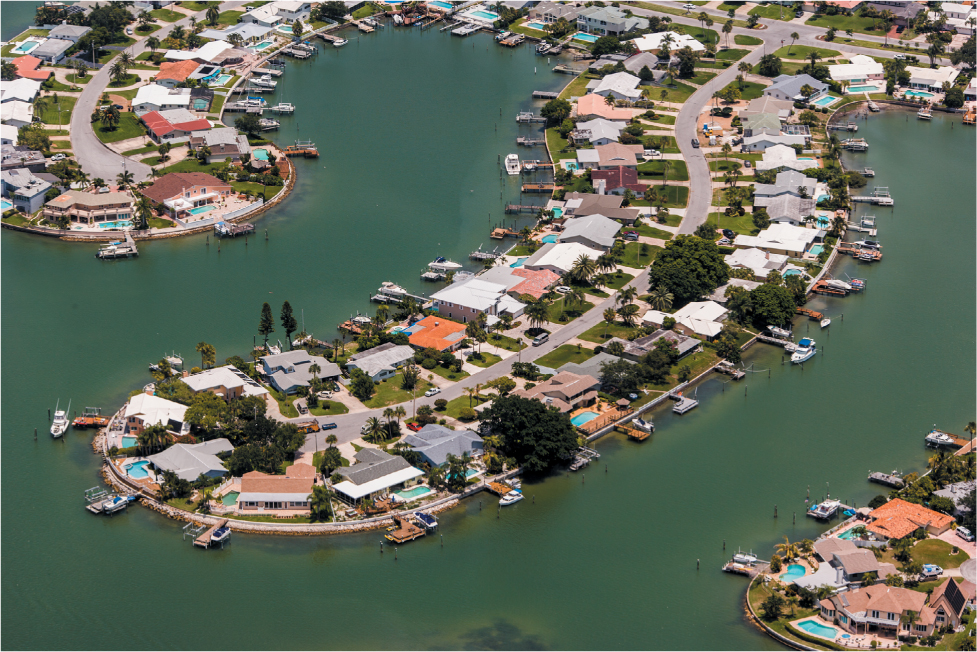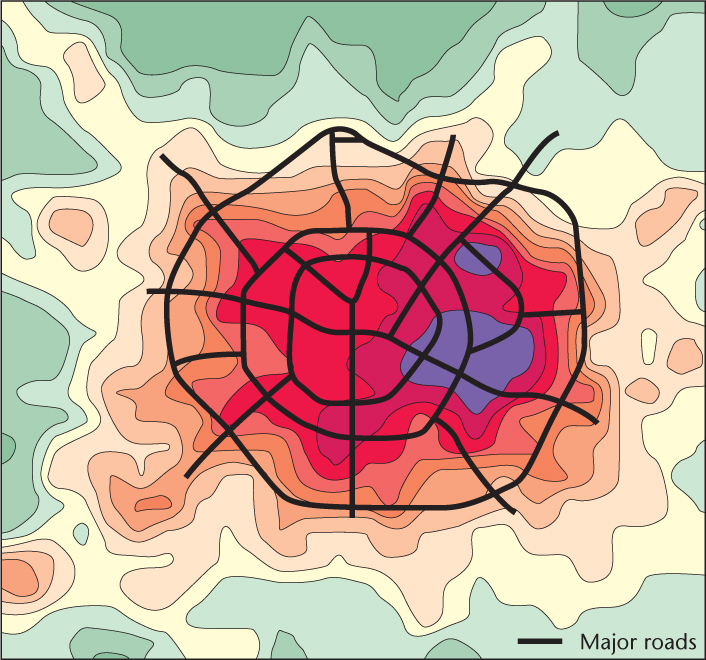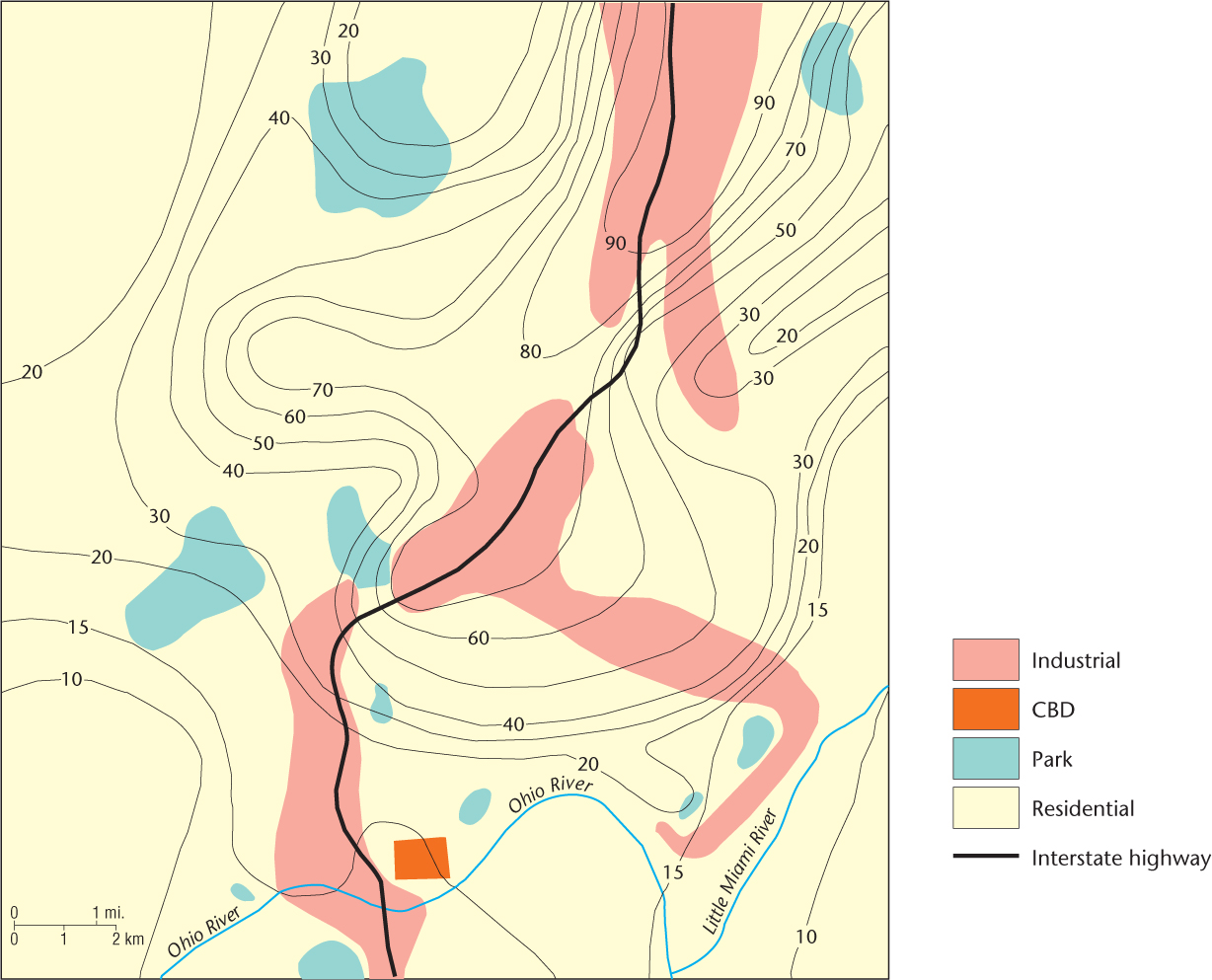The Cultural Ecology of the City
The Cultural Ecology of the City

How can we understand the relationships between the urban mosaic and the physical environment? The physical environment affects cities, just as urbanization profoundly alters natural environmental processes (Figure 11.15). The theme of cultural ecology helps us to organize information about these city-nature relationships.

Thinking Geographically
Question 11.18
8RuKc8128c8QLzSuCDDXGuz1xGAmdd3LyeqanMxM2stguex4ZcN9wjVyPifJWS7MEz6TnDZnpGiCJYxngYIyykxxX7JrntUVtj4c+Af70Kwc29fqdHI0PYrWljEJe1bsDM8qYGXzFEp9SmLgzE4MGAWfUO5rJAt/yCaDLf8Br0Q=Urban Weather and Climate
Urban Weather and Climate
Cities alter virtually all aspects of local weather and climate. Temperatures are higher in cities; rainfall is increased; the incidence of fog and cloudiness is greater; and levels of atmospheric pollution are much higher.
The causes of these changes are no mystery. Because cities cover large areas of land with streets, buildings, parking lots, and rooftops, about 50 percent of the urban area is a hard surface. Rainfall is quickly carried into gutters and sewers, so that little standing water is available for evaporation. Because evaporation removes heat from the air, when moisture is reduced, evaporation is lessened and air temperatures are higher.
heat island An area of warmer temperatures at the center of a city, caused by the urban concentration of heat-retaining concrete, brick, and asphalt.
Moreover, cities generate enormous amounts of heat. This heat comes not just from the heating systems of buildings but also from automobiles, industry, and even human bodies. One study showed that on a winter day in Manhattan, the amount of heat produced in the city is two and a half times the amount that reaches the ground from the sun. This results in a large mass of warmer air sitting over the city, called the urban heat island (Figure 11.16). The heat island causes yearly temperature averages in cities to be 3.5°F (2°C) higher than in the countryside; during the winter, when there is more city-produced heat, the average difference can easily reach 7°F to 10°F (4°C to 5.6°C).

Thinking Geographically
Question 11.19
ED/z+3UIi2IObOVOte4G389lEkuAZUfG0APX/BiuYCon0Rh4q3X4l/Rh3vbayErpJkGR+214k4nBwhR1v9fVkl/Tbk+n1ltS53ytOcotiFFP5cC9hrBgu+BSkdLxyM73zz+/BAGpZnPTQYCo/45bmORhUsfdvAkTdust dome A layer of pollution over a city that is thickest at the center of the city.
Urbanization also affects precipitation (rainfall and snowfall). Because of higher temperatures in the urban area, snowfall will be about 5 percent less than in the surrounding countryside. However, rainfall can be 5 percent to 10 percent higher. The increased rainfall results from two factors: the large number of dust particles in urban air and the higher city temperatures. Dust particles are a necessary precondition for condensation, offering a nucleus to which moisture can adhere. An abundance of dust particles, then, facilitates condensation. That is why fog and clouds are usually more frequent around cities. The term dust domes is used to refer to layers of pollution over a city. The dust dome is thickest at the center of the city (Figure 11.17).

Thinking Geographically
Question 11.20
KCtfO7ifPGNWGdvm/00MdbFAOvgI5gt4DcQbHxGz++Gj7VcYhPqqboxdWIS51mkPVAs0ZKTYQlk4u2zOzkdyB0eD7xD4mS0hhFH4htDulbEpEJ4cfqw2Xej28MoDQ4mABLuRGOdbXeKump3Ih+wx7TbtK+94Y2gFyRkleSnvR9cYBwldoL5TMdEjfsBj6XRhH6jHfQ==315
Urban Hydrology
Urban Hydrology
Not only is the city a great consumer of water, but it also alters runoff patterns in a way that increases the frequency and magnitude of flooding. Within the city, residential areas are usually the greatest consumers of water. Water consumption can vary, but generally each person in the United States uses about 60 gallons (264 liters) per day in a residence. Of course, residential demand varies. It is greater in drier climates as well as in middle- and high-income neighborhoods. Higher-income groups usually have a larger number of water-using appliances, such as washing machines, dishwashers, and swimming pools.
Urbanization can increase both the frequency and the magnitude of flooding because cities create large impervious areas where water cannot soak into the earth. Instead, precipitation is converted into immediate runoff. It is forced into gutters, sewers, and stream channels that have been straightened and stripped of vegetation, which results in more frequent high-water levels than are found in a comparable area of rural land. Furthermore, the time between rainfall and peak runoff is reduced in cities; there is more lag in the countryside, where water runs across soil and vegetation into stream channels and then into rivers. So, because of hard surfaces and artificial collection channels, runoff in cities is concentrated and immediate.
Urban Vegetation
Urban Vegetation
Until a decade ago, it was commonly thought that cities were made up mostly of artificial materials: asphalt, concrete, glass, and steel. Studies, however, show that about two-thirds of a typical North American city is composed of trees and herbaceous plants (mostly weeds in vacant lots and cultivated grasses in lawns). This urban vegetation is usually a mix of natural and introduced species and is a critical component of the urban ecosystem because it affects the city’s topography, hydrology, and meteorology.
316
More specifically, urban vegetation influences the quantity and quality of surface water and groundwater; reduces wind velocity and turbulence and temperature extremes; affects the pattern of snow accumulation and melting; absorbs thousands of tons of airborne particulates and atmospheric gases; and offers a habitat for mammals, birds, reptiles, and insects, all of which play some useful role in the urban ecosystem. Furthermore, urban vegetation influences the propagation of sound waves by muffling much of the city’s noise; affects the distribution of natural and artificial light; and, finally, is an extremely important component in the development of soil profiles—which, in turn, control hillside stability.
Our urban settlements are still closely tied to the physical environment. Cities change these natural processes in profound ways, and we must understand these disturbances in order to make better decisions about adjustments and control.